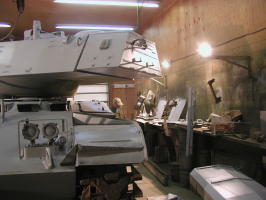|
Get
to know your VMMV staff & vehicles
In this
section we will introduce you to the people and armor of the
Virginia Museum of Military Vehicles. We will chat with the
VMMV staff, so that you can get to know the people who "keep
'em running" and work so hard behind the scenes. And also
provide a behind-the-scenes look into the history of individual
vehicles in the VMMV collection. In this, our thirteenth newsletter,
we will highlight a unique facet of VMMV….our world-class
restoration work for other armor museums in the United States.
VMMV’s
collection of armored fighting vehicles is dynamic, we are always
looking to acquire new or unique vehicles and sometimes we may
sell or trade a vehicle that we have more than one of. And sometimes,
another tank museum will ask our highly skilled mechanics and
fabricators to breathe life back into a vehicle and restore
it for display in their collection.
In October
2008, a major collector of armored vehicles contacted VMMV about
acquiring an M41 Walker Bulldog tank for display in his new
armor museum. The museum opening was set for January 15, 2009,
so the VMMV staff and volunteers knew it was going to be an
all-hands-on-deck project, but relished the challenge.
The
vehicle selected came to VMMV in the early 1990’s from
the Belgian Army and is shown here. This particular M41 is an
early production model with the straight front fenders although
it has the later fabricated T-shaped muzzle brake.
Staffers
Marc S., Alan B., and Jason W. led the effort. Their long hours
during the fall and winter of 2008 added up….by the time
the last lettering was applied they had worked over 600 hours
restoring the M41, along with many hours invested by VMMV volunteers.
But the pictures shown below illustrate the dazzling end result—a
nicely restored M41 that any museum in the world would be proud
to display.
There
were many challenges to overcome in this restoration beyond
the short timeline….the vehicle needed work on the turret
and engine and elements of the electrical and hydraulic systems
needed to be replaced. Marc and Alan divided up the tasks and
each tackled a different project. That took quite a bit of effort
as several gremlins needed to be isolated and fixed.
After
all the interior work was accomplished, VMMV staff and volunteers
took on the exterior. Properly prepping a vehicle prior to painting
is critical. Without fixing rusted areas or shooting good primer
the new paint will flake off. So the needle guns and scuff pads
made their appearance. Elbows flew as the surface was stripped
off to bare metal prior to shooting it with zinc chromate, primer
and two coats of semi-gloss Olive Drab 24087. On January 6,
the work crews of VMMV stepped back to admire their restoration
handiwork….a beautiful M41 Walker Bulldog tank.
|















